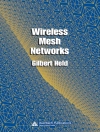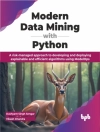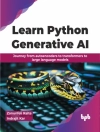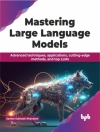This book provides a comprehensive exploration of computational intelligence techniques and their applications, offering valuable insights into advanced information processing, machine learning concepts, and their impact on agile manufacturing systems.
Computational Intelligence presents a new concept for advanced information processing. Computational Intelligence (CI) is the principle, architecture, implementation, and growth of machine learning concepts that are physiologically and semantically inspired. Computational Intelligence methods aim to develop an approach to evaluating and creating flexible processing of human information, such as sensing, understanding, learning, recognizing, and thinking. The Artificial Neural Network simulates the human nervous system’s physiological characteristics and has been implemented numerically for non-linear mapping. Fuzzy Logic Systems simulate the human brain’s psychological characteristics and have been used for linguistic translation through membership functions and bioinformatics. The Genetic Algorithm simulates computer evolution and has been applied to solve problems with optimization algorithms for improvements in diagnostic and treatment technologies for various diseases. To expand the agility and learning capacity of manufacturing systems, these methods play essential roles. This book will express the computer vision techniques that make manufacturing systems more flexible, efficient, robust, adaptive, and productive by examining many applications and research into computational intelligence techniques concerning the main problems in design, making plans, and manufacturing goods in agile manufacturing systems.
Содержание
Introduction xvii
1 Computational Intelligence Theory: An Orientation Technique 1
S. Jaisiva, C. Kumar, S. Sakthiya Ram, C. Sakthi Gokul Rajan and P. Praveen Kumar
1.1 Computational Intelligence 2
1.2 Application Fields for Computational Intelligence 4
1.2.1 Neural Networks 4
1.2.1.1 Classification 4
1.2.1.2 Clustering or Compression 5
1.2.1.3 Generation of Sequences or Patterns 5
1.2.1.4 Control Systems 5
1.2.1.5 Evolutionary Computation 6
1.2.2 Fuzzy Logic 6
1.2.2.1 Fuzzy Control Systems 6
1.2.2.2 Fuzzy Systems 6
1.2.2.3 Behavioral Motivations for Fuzzy Logic 7
1.3 Computational Intelligence Paradigms 7
1.3.1 Artificial Neural Networks 7
1.3.2 Evolutionary Computation (EC) 10
1.3.3 Optimization Method 11
1.3.3.1 Optimization 11
1.4 Architecture Assortment 12
1.4.1 Swarm Intelligence 14
1.4.2 Artificial Immune Systems 14
1.5 Myths About Computational Intelligence 15
1.6 Supervised Learning in Computational Intelligence 16
1.6.1 Performance Measures 17
1.6.1.1 Accuracy 17
1.6.1.2 Complexity 18
1.6.1.3 Convergence 19
1.6.2 Performance Factors 19
1.6.2.1 Data Preparation 19
1.6.2.2 Scaling and Normalization 19
1.6.2.3 Learning Rate and Momentum 20
1.6.2.4 Learning Rate 20
1.6.2.5 Noise Injection 20
1.7 Training Set Manipulation 21
1.8 Conclusion 21
References 21
2 Nature-Inspired Algorithms for Computational Intelligence Theory—A State-of-the-Art Review 25
B. Akoramurthy, K. Dhivya and B. Surendiran
2.1 Introduction 25
2.2 Related Works 27
2.3 Optimization and Its Algorithms 28
2.3.1 Definition 28
2.3.2 Mathematical Notations 28
2.3.3 Gradient-Based Algorithms 29
2.3.4 Gradient-Free Optimizers or Algorithms 31
2.4 Metaheuristic Optimization Methods 32
2.4.1 Ant Colony Algorithm 32
2.4.1.1 Ant Colony Optimization Algorithm 32
2.4.2 Flower Pollination Algorithm 34
2.4.3 Genetic Algorithms 35
2.4.4 Evolutionary Algorithm 36
2.4.5 Method Based on Bats 37
2.4.6 Cuckoo Searching Method 38
2.4.7 Firefly Algorithm 39
2.4.8 Particle Swarm Optimization Algorithm 41
2.4.9 Krill Herd Algorithm 42
2.4.10 Artificial Bee Colony (ABC) 43
2.5 Computational and Autonomous Systems 44
2.5.1 Computational Features of Nature-Inspired Computing 44
2.5.2 Comparison with Legacy Algorithms 45
2.5.3 Autonomous Criticality Systems 46
2.6 Unresolved Issues for Continued Study 47
References 49
3 AI-Based Computational Intelligence Theory 53
Jana Selvaganesan, S. Arunmozhiselvi, E. Preethi and S. Thangam
3.1 Computational Intelligence 54
3.2 Designing Expert Systems 55
3.2.1 Characteristics 56
3.3 Core of Computational Intelligence 56
3.3.1 Artificial Intelligence (AI) 56
3.3.2 Machine Learning (ML) 57
3.3.3 Neural Networks 57
3.3.4 Evolutionary Computation 58
3.3.5 Fuzzy Systems 58
3.3.6 Swarm Intelligence 59
3.3.7 Bayesian Networks 60
3.3.8 Optimization Techniques 60
3.3.9 Data Mining and Pattern Recognition 60
3.3.10 Decision Support Systems 61
3.3.11 Hybrid Approaches 61
3.4 Research and Development 62
3.4.1 Government Plans in Enriching AI-Based Computational Intelligence Theory 62
3.4.1.1 Funding and Research Initiatives 62
3.4.1.2 Policy and Regulation 62
3.4.1.3 Standards and Interoperability 63
3.4.1.4 Education and Workforce Development 63
3.4.1.5 Industry Collaboration and Partnerships 63
3.4.1.6 Ethical Guidelines and Responsible AI 63
3.4.1.7 International Collaboration and Governance 64
3.5 New Opportunities and Challenges 64
3.5.1 Explainable AI (XAI) 64
3.5.2 Adversarial Machine Learning 65
3.5.3 AI for Edge Computing 65
3.5.4 Continual Learning 67
3.5.5 Meta-Learning 68
3.5.6 AI for Cybersecurity 69
3.5.7 AI for Healthcare 70
3.5.7.1 AI for Healthcare-Based Recommendation System 72
3.5.8 Responsible AI 72
3.5.9 AI and Robotics Integration 73
3.5.10 AI for Sustainability and Climate Change 74
3.5.11 Quantum Computing and AI 75
3.5.12 Human–AI Collaboration 76
3.6 Applications 77
3.6.1 Google-Waymo Car 77
3.6.2 Chat GPT 79
3.6.3 Boston Dynamics’ Atlas 80
3.6.4 Netflix 81
3.6.5 Trinetra 82
3.6.6 Voice-Activated Backpack 83
3.7 Case Study: YOLO v7 for Object Detection in Tensor Flow 84
3.7.1 Yolo V 7 84
3.7.2 Working and Its Features 85
3.7.3 Configuration to Deploy YOLO V 7 87
3.8 Results 88
3.9 Performance Analysis 89
3.10 Challenges in Automation 91
3.10.1 Marching Towards Solution 92
3.11 Conclusion 93
References 93
4 Information Processing, Learning, and Its Artificial Intelligence 97
P. Praveenkumar, Pragati M., Prathiba S., Mirthulaa G., Supriya P., Jayashree B. and Jayasri R.
4.1 Introduction—Artificial Intelligence 98
4.2 Artificial Intelligence and Its Learning 99
4.3 Artificial Intelligence’s Effects on IT 100
4.4 Examples of Artificial Intelligence 101
4.4.1 Smart Learning Content 101
4.4.2 Intelligent Tutorial System Future 103
4.4.3 Virtual Facilitators and Learning Environment 104
4.4.4 Content Analytics 105
4.5 Data Processing and AI in Human-Centered Manufacturing 106
4.6 Information Learning 107
4.6.1 Information Learning Through AI—Chatbots 107
4.6.2 Information Learning Through AI—Virtual Reality (vr) 108
4.6.3 Information Learning Through AI—Management of Learning (LMS) 110
4.6.4 Information Learning Through AI—Robotics 111
4.6.5 AI Invoice Processing is Not Fantastical— It is Fantastic 113
4.7 Results 113
4.8 Conclusion 114
References 114
5 Computational Intelligence Approach for Exploration of Spatial Co-Location Patterns 117
S. Lourdu Marie Sophie, S. Siva Sathya, S. Sharmiladevi and J. Dhakshayani
5.1 Introduction 118
5.2 Spatial Data Mining 120
5.2.1 Spatial Co-Location Pattern Mining 120
5.3 Preliminaries 123
5.3.1 Basic Concepts 123
5.3.1.1 Feature Instance 124
5.3.1.2 Participation Ratio (PR) 124
5.3.1.3 Participation Index (PI) 125
5.3.1.4 Neighbor Relation 125
5.3.1.5 Conditional Neighborhood 126
5.3.2 Apache Hadoop—Map Reduce 126
5.3.3 Related Work 128
5.4 Proposed Grid-Conditional Neighborhood Algorithm 130
5.4.1 Module Description 131
5.4.1.1 Search Neighbor 131
5.4.1.2 Group Neighbors 132
5.4.1.3 Pattern Search 133
5.4.1.4 Top K Pattern Generation 133
5.5 Experimental Setup and Analysis 134
5.5.1 Dataset Used 134
5.5.2 Performance Analysis 136
5.6 Discussion and Conclusion 138
References 140
6 Computational Intelligence-Based Optimal Feature Selection Techniques for Detecting Plant Diseases 145
Karthickmanoj R., S. Aasha Nandhini and T. Sasilatha
6.1 Introduction 145
6.2 Literature Survey 146
6.3 Proposed Framework 151
6.4 Simulation Results 152
6.5 Summary 156
References 156
7 Protein Structure Prediction Using Convolutional Neural Networks Augmented with Cellular Automata 159
Pokkuluri Kiran Sree, Prasun Chakrabarti, Martin Margala and SSSN Usha Devi N.
7.1 Introduction 160
7.2 Methods 162
7.3 Design of the Model 164
7.4 Results and Comparisons 167
7.5 Conclusion 172
References 172
8 Modeling and Approximating Renewable Energy Systems Using Computational Intelligence 175
B. Balaji, P. Hemalatha, T. Rampradesh, G. Anbarasi and A. Eswari
8.1 Introduction 176
8.2 Expert System 178
8.3 Artificial Neural Networks 179
8.4 ANN in Renewable Energy Systems 182
8.5 Conclusion 185
References 186
9 Computational Intelligence and Deep Learning in Health Informatics: An Introductory Perspective 189
J. Naskath, R. Rajakumari, Hamza Aldabbas and Zaid Mustafa
9.1 Introduction 190
9.2 Mobile Application in Health Informatics Using Deep Learning 191
9.3 Health Informatics Wearables Using Deep Learning 197
9.4 Electroencephalogram 202
9.5 Conclusion 203
References 207
10 Computational Intelligence for Human Activity Recognition (HAR) 213
Thangapriya and Nancy Jasmine Goldena
10.1 Introduction 214
10.2 Fuzzy Logic in Human Judgment and Decision-Making 215
10.2.1 FL Algorithm 216
10.2.2 Applications of FL 217
10.2.3 Advantages of FL 217
10.2.4 Disadvantages of FL 218
10.2.5 Utilizing FLS and FIS in HAR Research and Health Monitoring 218
10.3 Artificial Neural Networks: From Perceptrons to Modern Applications 219
10.3.1 ANN Algorithm 221
10.3.2 Applications of ANN 222
10.3.3 Advantages of ANN 222
10.3.4 Disadvantages of ANN 222
10.3.5 Artificial Neural Networks in HAR Research 223
10.4 Swarm Intelligence 223
10.4.1 SI Algorithm 224
10.4.2 Applications of SI 224
10.4.3 Advantages of SI 225
10.4.4 Disadvantages of SI 225
10.4.5 Swarm Intelligence Techniques in HAR Research 225
10.5 Evolutionary Computing 226
10.5.1 EC Algorithm 226
10.5.2 Applications of EC 227
10.5.3 Advantages of EC 228
10.5.4 Disadvantages of EC 228
10.5.5 Harnessing Evolutionary Computation for HAR Research 228
10.6 Artificial Immune System 228
10.6.1 AIS Algorithm 229
10.6.2 Applications of AIS 230
10.6.3 Advantages of AIS 230
10.6.4 Disadvantages of AIS 230
10.6.5 Harnessing AIS for Preventive Measures 231
10.7 Conclusion 231
References 232
11 Computational Intelligence for Multimodal Analysis of High-Dimensional Image Processing in Clinical Settings 235
B. Balaji, P. Pugazhendiran, N. Sivanantham, N. Velammal and P. Vimala
11.1 Basics of Machine Learning 236
11.2 Feature Extraction 237
11.3 Selection of Features 238
11.4 Statistical Classifiers 239
11.5 Neural Networks 242
11.6 Biometric Analysis 244
11.7 Data from High-Resolution Medical Imaging 251
11.8 Computational Architectures 255
11.9 Timing and Uncertainty 256
11.10 AI and Risk of Harm 258
11.11 Conclusion 259
References 259
12 A Review of Computational Intelligence-Based Biometric Recognition Methods 263
T. Ilam Parithi, K. Antony Sudha and D. Jessintha
12.1 Introduction 263
12.1.1 Objective 264
12.2 Computational Intelligence 264
12.3 CI-Based Biometric Recognition 266
12.3.1 Acquisition 266
12.3.2 Segmentation 266
12.3.3 Quality Assessment 269
12.3.4 Enhancement 270
12.3.5 Feature Extraction 270
12.3.6 Matching 271
12.3.7 Classification 272
12.3.8 Score Normalization 272
12.3.9 Anti-Spoofing 272
12.3.10 Privacy 273
12.4 Applications 273
12.4.1 Business 273
12.4.2 Education 274
12.4.3 Military 275
12.4.4 Health Care 276
12.4.5 Banking 276
12.5 Conclusion 277
References 277
13 Seeing the Unseen: An Automated Early Breast Cancer Detection Using Hyperspectral Imaging 281
Sravan Kumar Sikhakolli, Suresh Aala, Sunil Chinnadurai and Inbarasan Muniraj
13.1 Introduction 282
13.1.1 Conventional Imaging Methods for Detecting BC 283
13.1.2 Optical Imaging Techniques to Detect BC 284
13.2 Hyperspectral Imaging (HSI) 285
13.2.1 How Does HSI Setup Look Like? 286
13.3 State-of-the-Art Techniques for BC Detection 287
13.3.1 Breast Cancer Ex Vivo Analysis 287
13.3.2 Breast Cancer In Vivo Analysis 290
13.4 Artificial Intelligence in BC Detection Using HSI 291
13.4.1 Deep Learning in HSI 291
13.4.2 Convolutional Neural Networks 292
13.4.3 Deep Belief Networks Using HSI 293
13.4.4 Residual Networks 293
13.5 Discussion and Conclusion 293
References 294
14 Shedding Light into the Dark: Early Oral Cancer Detection Using Hyperspectral Imaging 301
Suresh Aala, Sravan Kumar Sikhakolli, Inbarasan Muniraj and Sunil Chinnadurai
14.1 Introduction 302
14.2 HSI in HNC Detection 305
14.3 Deep Learning in In Vivo HSI 313
14.3.1 Endoscopic 313
14.4 Conclusion and Future Research Directions 315
References 316
15 Machine Learning Techniques for Glaucoma Screening Using Optic Disc Detection 321
V. Subha, S. Niraja P. Rayen and Manivanna Boopathi
15.1 Introduction 322
15.1.1 Ophthalmic Process 324
15.1.2 Digital Imaging 324
15.1.2.1 Image Processing 325
15.1.3 Eye and Its Parts 326
15.1.3.1 Optic Disc 327
15.1.3.2 Aqueous Humor 327
15.1.3.3 Choroid 327
15.1.3.4 Ciliary Body 327
15.1.3.5 Ciliary Muscle 327
15.1.3.6 Iris 328
15.1.3.7 Pupil 328
15.1.3.8 Retina 328
15.1.3.9 Photoreceptor Cells 328
15.1.3.10 Retinal Blood Vessels 328
15.1.3.11 Sclera 329
15.1.3.12 Uvea 329
15.1.3.13 Visual Axis 329
15.1.3.14 Visual Cortex 329
15.1.3.15 Visual Fields 329
15.1.3.16 Vitreous 329
15.1.3.17 Zonules 330
15.1.3.18 Macula (Yellow Spot) 330
15.1.3.19 Optic Nerve 330
15.1.4 Eye Diseases 330
15.1.4.1 Myopia 330
15.1.4.2 Hyperopia 330
15.1.4.3 Astigmatism 330
15.1.4.4 Presbyopia 331
15.1.4.5 Strabismus 331
15.1.4.6 Amblyopia 331
15.1.4.7 Cataracts 331
15.1.4.8 Glaucoma 332
15.1.5 Indications of Glaucoma 332
15.1.6 Causes of Glaucoma 332
15.1.6.1 Dietary 332
15.1.6.2 Ethnicity and Gender 332
15.1.6.3 Genetics 333
15.1.7 Analytical Methods of Glaucoma 333
15.2 Glaucoma Screening with Optic Disc and Classification 334
15.2.1 Optic Disc Detection 335
15.2.2 Cropping ROI 337
15.2.3 Optic Disc Segmentation 338
15.2.4 Optic Cup Segmentation 338
15.2.5 Post-Processing 340
15.2.5.1 Cup–Disc Ratio 340
15.2.5.2 Evaluation of the NRR Area in the ISNT Quadrants 341
15.2.5.3 Superpixel Method 341
15.2.5.4 Level Set Method 342
15.3 Experimental Section 342
15.3.1 Dataset Description 342
15.3.2 Experimental Images 343
15.3.3 Experimental Testing Phase 343
15.3.4 Performance Analysis 344
15.4 Conclusion 345
References 346
16 Role of Artificial Intelligence in Marketing 349
G. Muruganantham and R.S. Aswanth
16.1 Introduction 350
16.1.1 Impact of AI in Marketing 351
16.1.2 Benefits of AI in Marketing 352
16.1.3 AI in Marketing Functions 354
16.1.4 Applications of AI in Marketing 354
16.1.5 Challenges of AI in Marketing 356
16.1.6 Future of AI in Marketing 357
16.2 New Trends of AI in Marketing 358
16.2.1 Companies Using AI in Marketing 359
16.3 Aspects of AI in Marketing across Different Industries 362
16.4 Conclusion 364
References 365
About the Editors 369
Index 371
Об авторе
T. Ananth Kumar, Ph D, is an associate professor at the Indo French Educational Trust College of Engineering, Anna University, Chennai, India. He has presented papers in various national and international conferences and journals, as well as many book chapters. Additionally, he is a lifetime member of the Indian Society of Technical Education and has many patents spanning across various domains.
E. Golden Julie, Ph D, is currently working as a Senior Assistant Professor in the department of Computer Science and Engineering, Anna University, Tirunelveli, India. She has more than 12 years of experience in teaching, has published more than 34 papers in various international journals, presented more than 20 papers in both national and international conferences, and written ten book chapters. She has given many guest lectures on various subjects such as multicore architecture, operating systems, and compiler design in premier institutions. Additionally, she is an active lifetime member of the Indian Society of Technical Education.
Venkata Raghuveer Burugadda is a senior solution architect and technology leader with over 16 years of experience across the United States and India in product delivery and technology transformation, driving growth for a global network in remittances and payments. He modernized a point of sale solution with new and organizational common architecture to deliver a fast and efficient user experience and allow easy integration of new capabilities through the adoption of cloud migration, devops, test driven principles, and user-centric solutions.
Abhishek Kumar, Ph D, is currently working as an associate professor and the assistant director of the Computer Science & Engineering Department at Chandigarh University, Punjab, India. He has more than 11 years of teaching experience and has been a session chair and keynote speaker for many international conferences and webinars. In addition to his experience, he has more than 100 publications in reputed, peer-reviewed national and international journals, books, and conferences, has authored or co-authored seven books published, and edited an additional 27 books.
Puneet Kumar, Ph D, is a professor and the head of the Department of Computer Science & Engineering at the University Institute of Engineering, Chandigarh University, Mohali, India. He has more than 18 years of teaching, research, and industrial experience and has published various research papers and articles in national and international journals, many of which are widely cited across the world. He is also the recipient of several software copyrights from the Ministry of Human Resource and Development, Government of India.












